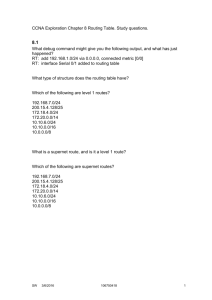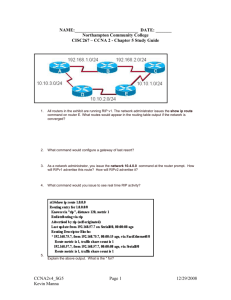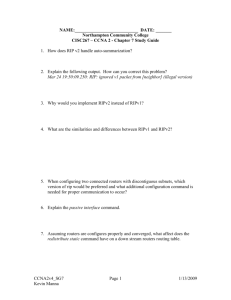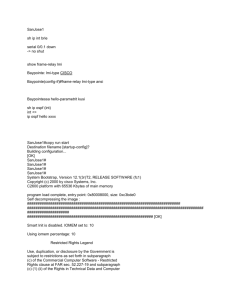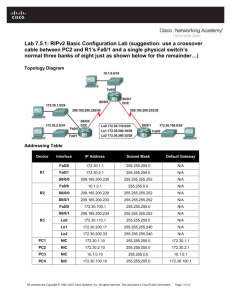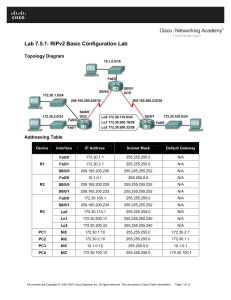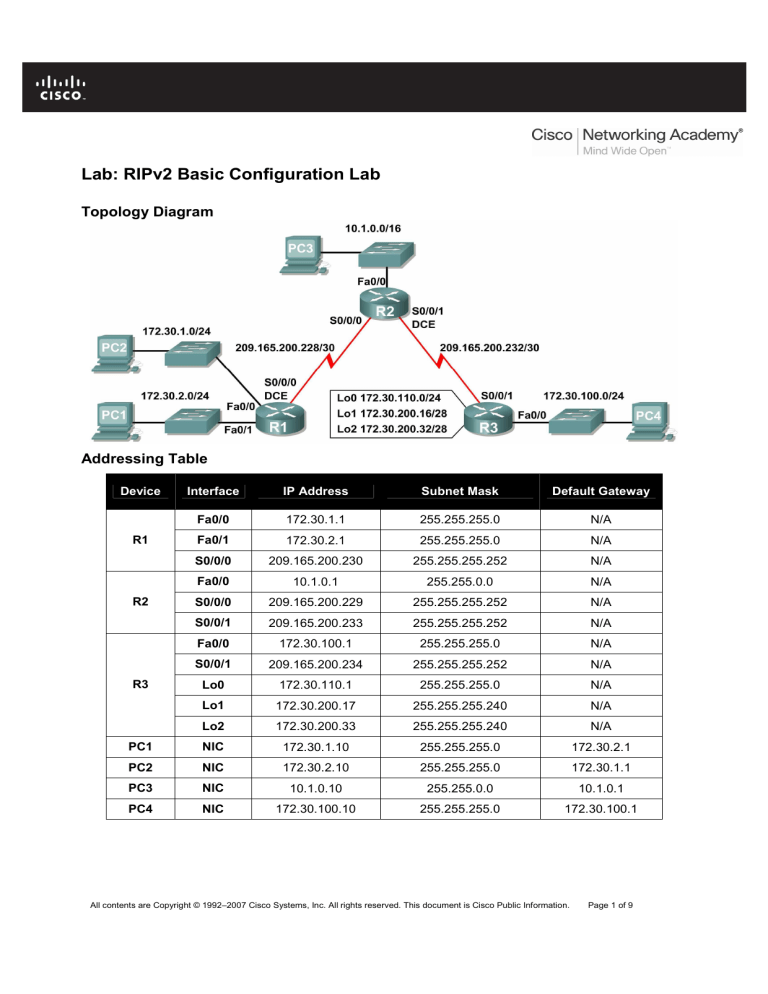
Lab: RIPv2 Basic Configuration Lab
Topology Diagram
Addressing Table
Device
Interface
IP Address
Subnet Mask
Default Gateway
Fa0/0
172.30.1.1
255.255.255.0
N/A
Fa0/1
172.30.2.1
255.255.255.0
N/A
S0/0/0
209.165.200.230
255.255.255.252
N/A
Fa0/0
10.1.0.1
255.255.0.0
N/A
S0/0/0
209.165.200.229
255.255.255.252
N/A
S0/0/1
209.165.200.233
255.255.255.252
N/A
Fa0/0
172.30.100.1
255.255.255.0
N/A
S0/0/1
209.165.200.234
255.255.255.252
N/A
Lo0
172.30.110.1
255.255.255.0
N/A
Lo1
172.30.200.17
255.255.255.240
N/A
Lo2
172.30.200.33
255.255.255.240
N/A
PC1
NIC
172.30.1.10
255.255.255.0
172.30.2.1
PC2
NIC
172.30.2.10
255.255.255.0
172.30.1.1
PC3
NIC
10.1.0.10
255.255.0.0
10.1.0.1
PC4
NIC
172.30.100.10
255.255.255.0
172.30.100.1
R1
R2
R3
All contents are Copyright © 1992–2007 Cisco Systems, Inc. All rights reserved. This document is Cisco Public Information.
Page 1 of 9
CCNA Exploration
Routing Protocols and Concepts: RIPv2
Lab: RIPv2 Basic Configuration Lab
Step 1: Configure the routers
On the routers, enter global configuration mode and configure the hostname as shown on the chart. Then
configure the console, virtual terminal lines password (both “cisco”) and privileged EXEC password
(“class”):
Step 2: Add the logging synchronous command to the console and virtual terminal lines
This command is very helpful in both lab and production environments and uses the following syntax:
Router(config-line)#logging synchronous
Step 3: Disable DNS lookup
Router(config)#no ip domain-lookup
Step 4: Configure the interfaces on R1, R2, and R3
Configure the interfaces on the R1, R2, and R3 routers with the IP addresses from the table under the
Topology Diagram.
Step 5: Verify IP addressing and interfaces
Use the show ip interface brief command to verify that the IP addressing is correct and that the
interfaces are active.
Step 6: Configure Ethernet interfaces of PC1, PC2, and PC3
Configure the Ethernet interfaces of PC1, PC2, and PC3 with the IP addresses and default gateways
from the table under the Topology Diagram.
Step 7: Test the PC configuration by pinging the default gateway from the PC
Step 8: Configure RIP
To enable RIP, enter the command router rip in global configuration mode.
Router(config)#router rip
Once you are in routing configuration mode, enter the classful network address for each directly
connected network, using the network command with the following syntax:
Router(config-router)#network <network_nr>
Router(config-router)#network <network_nr>
Task: Examine the Current Status of the Network.
Step 1: Verify that both serial links are up.
The two serial links can quickly be verified using the show ip interface brief command on R2.
R2#show ip interface brief
Interface
IP-Address
FastEthernet0/0
10.1.0.1
FastEthernet0/1
unassigned
Serial0/0/0
209.165.200.229
Serial0/0/1
209.165.200.233
Vlan1
unassigned
OK?
YES
YES
YES
YES
YES
Method
manual
manual
manual
manual
manual
Status
Protocol
up
up
administratively down down
up
up
up
up
administratively down down
All contents are Copyright © 1992–2007 Cisco Systems, Inc. All rights reserved. This document is Cisco Public Information.
Page 2 of 9
CCNA Exploration
Routing Protocols and Concepts: RIPv2
Lab: RIPv2 Basic Configuration Lab
Step 2: Check the connectivity from R2 to the hosts on the R1 and R3 LANs.
From the R2 router, how many ICMP messages are successful when pinging PC1?
_______________________________________________________________________
From the R2 router, how many ICMP messages are successful when pinging PC4?
______________________________________________________________________
Step 3: Check the connectivity between the PCs.
From the PC1, is it possible to ping PC2? __________
What is the success rate? __________
From the PC1, is it possible to ping PC3? __________
What is the success rate? __________
From the PC1, is it possible to ping PC4? __________
What is the success rate? __________
From the PC4, is it possible to ping PC2? __________
What is the success rate? __________
From the PC4, is it possible to ping PC3? __________
What is the success rate? __________
Step 4: View the routing table on R2.
Both the R1 and R3 are advertising routes to the 172.30.0.0/16 network; therefore, there are two entries
for this network in the R2 routing table. The R2 routing table only shows the major classful network
address of 172.30.0.0—it does not show any of the subnets for this network that are used on the LANs
attached to R1 and R3. Because the routing metric is the same for both entries, the router alternates the
routes that are used when forwarding packets that are destined for the 172.30.0.0/16 network.
R2#show ip route
Output omitted
C
R
C
C
10.0.0.0/16 is subnetted, 1 subnets
10.1.0.0 is directly connected, FastEthernet0/0
172.30.0.0/16 [120/1] via 209.165.200.230, 00:00:24, Serial0/0/0
[120/1] via 209.165.200.234, 00:00:15, Serial0/0/1
209.165.200.0/30 is subnetted, 2 subnets
209.165.200.228 is directly connected, Serial0/0/0
209.165.200.232 is directly connected, Serial0/0/1
Step 5: Examine the routing table on the R1 router.
Both R1 and R3 are configured with interfaces on a discontiguous network, 172.30.0.0. The 172.30.0.0
subnets are physically and logically divided by at least one other classful or major network—in this case,
the two serial networks 209.165.200.228/30 and 209.165.200.232/30. Classful routing protocols like
RIPv1 summarize networks at major network boundaries. Both R1 and R3 will be summarizing
172.30.0.0/24 subnets to 172.30.0.0/16. Because the route to 172.30.0.0/16 is directly connected, and
because R1 does not have any specific routes for the 172.30.0.0 subnets on R3, packets destined for the
R3 LANs will not be forwarded properly.
All contents are Copyright © 1992–2007 Cisco Systems, Inc. All rights reserved. This document is Cisco Public Information.
Page 3 of 9
CCNA Exploration
Routing Protocols and Concepts: RIPv2
Lab: RIPv2 Basic Configuration Lab
R1#show ip route
Output omitted
R
C
C
C
R
10.0.0.0/8 [120/1] via 209.165.200.229, 00:00:02, Serial0/0/0
172.30.0.0/24 is subnetted, 2 subnets
172.30.1.0 is directly connected, FastEthernet0/0
172.30.2.0 is directly connected, FastEthernet0/1
209.165.200.0/30 is subnetted, 2 subnets
209.165.200.228 is directly connected, Serial0/0/0
209.165.200.232 [120/1] via 209.165.200.229, 00:00:02, Serial0/0/0
Step 6: Examine the routing table on the R3 router.
R3 only shows its own subnets for 172.30.0.0 network: 172.30.100/24, 172.30.110/24, 172.30.200.16/28,
and 172.30.200.32/28. R3 does not have any routes for the 172.30.0.0 subnets on R1.
R3#show ip route
Output omitted
R
C
C
C
C
R
C
10.0.0.0/8 [120/1] via 209.165.200.233, 00:00:19, Serial0/0/1
172.30.0.0/16 is variably subnetted, 4 subnets, 2 masks
172.30.100.0/24 is directly connected, FastEthernet0/0
172.30.110.0/24 is directly connected, Loopback0
172.30.200.16/28 is directly connected, Loopback1
172.30.200.32/28 is directly connected, Loopback2
209.165.200.0/30 is subnetted, 2 subnets
209.165.200.228 [120/1] via 209.165.200.233, 00:00:19, Serial0/0/1
209.165.200.232 is directly connected, Serial0/0/1
Step 7: Examine the RIPv1 packets that are being received by R2.
Use the debug ip rip command to display RIP routing updates.
R2 is receiving the route 172.30.0.0, with 1 hop, from both R1 and R3. Because these are equal cost
metrics, both routes are added to the R2 routing table. Because RIPv1 is a classful routing protocol, no
subnet mask information is sent in the update.
R2#debug ip rip
RIP protocol debugging is on
RIP: received v1 update from 209.165.200.234 on Serial0/0/1
172.30.0.0 in 1 hops
RIP: received v1 update from 209.165.200.230 on Serial0/0/0
172.30.0.0 in 1 hops
R2 is sending only the routes for the 10.0.0.0 LAN and the two serial connections to R1 and R3. R1
and R3 are not receiving any information about the 172.30.0.0 subnet routes.
RIP: sending v1 update to 255.255.255.255 via Serial0/0/1
(209.165.200.233)
RIP: build update entries
network 10.0.0.0 metric 1
network 209.165.200.228 metric 1
All contents are Copyright © 1992–2007 Cisco Systems, Inc. All rights reserved. This document is Cisco Public Information.
Page 4 of 9
CCNA Exploration
Routing Protocols and Concepts: RIPv2
Lab: RIPv2 Basic Configuration Lab
RIP: sending v1 update to 255.255.255.255 via Serial0/0/0
(209.165.200.229)
RIP: build update entries
network 10.0.0.0 metric 1
network 209.165.200.232 metric 1
When you are finished, turn off the debugging.
R2#undebug all
Task: Configure RIP Version 2.
Step 1: Use the version 2 command to enable RIP version 2 on each of the routers.
R2(config)#router rip
R2(config-router)#version 2
R1(config)#router rip
R1(config-router)#version 2
R3(config)#router rip
R3(config-router)#version 2
RIPv2 messages include the subnet mask in a field in the routing updates. This allows subnets and their
masks to be included in the routing updates. However, by default RIPv2 summarizes networks at major
network boundaries, just like RIPv1, except that the subnet mask is included in the update.
Step 2: Verify that RIPv2 is running on the routers.
The debug ip rip, show ip protocols, and show run commands can all be used to confirm that
RIPv2 is running. The output of the show ip protocols command for R1 is shown below.
R1# show ip protocols
Routing Protocol is "rip"
Sending updates every 30 seconds, next due in 7 seconds
Invalid after 180 seconds, hold down 180, flushed after 240
Outgoing update filter list for all interfaces is not set
Incoming update filter list for all interfaces is not set
Redistributing: rip
Default version control: send version 2, receive 2
Interface
Send Recv Triggered RIP Key-chain
FastEthernet0/0
2
2
FastEthernet0/1
2
2
Serial0/0/0
2
2
Automatic network summarization is in effect
Maximum path: 4
Routing for Networks:
172.30.0.0
209.165.200.0
Passive Interface(s):
FastEthernet0/0
FastEthernet0/1
Routing Information Sources:
Gateway
Distance
Last Update
209.165.200.229
120
All contents are Copyright © 1992–2007 Cisco Systems, Inc. All rights reserved. This document is Cisco Public Information.
Page 5 of 9
CCNA Exploration
Routing Protocols and Concepts: RIPv2
Lab: RIPv2 Basic Configuration Lab
Distance: (default is 120)
Task: Examine the Automatic Summarization of Routes.
The LANs connected to R1 and R3 are still composed of discontiguous networks. R2 still shows two
equal cost paths to the 172.30.0.0/16 network in the routing table. R2 still shows only the major classful
network address of 172.30.0.0 and does not show any of the subnets for this network.
R2#show ip route
Output omitted
C
R
C
C
10.0.0.0/16 is subnetted, 1 subnets
10.1.0.0 is directly connected, FastEthernet0/0
172.30.0.0/16 [120/1] via 209.165.200.230, 00:00:07, Serial0/0/0
[120/1] via 209.165.200.234, 00:00:08, Serial0/0/1
209.165.200.0/30 is subnetted, 2 subnets
209.165.200.228 is directly connected, Serial0/0/0
209.165.200.232 is directly connected, Serial0/0/1
R1 still shows only its own subnets for the 172.30.0.0 network. R1 still does not have any routes for the
172.30.0.0 subnets on R3.
R1#show ip route
Output omitted
R
C
C
C
R
10.0.0.0/8 [120/1] via 209.165.200.229, 00:00:09, Serial0/0/0
172.30.0.0/24 is subnetted, 2 subnets
172.30.1.0 is directly connected, FastEthernet0/0
172.30.2.0 is directly connected, FastEthernet0/1
209.165.200.0/30 is subnetted, 2 subnets
209.165.200.228 is directly connected, Serial0/0/0
209.165.200.232 [120/1] via 209.165.200.229, 00:00:09, Serial0/0/0
R3 still only shows its own subnets for the 172.30.0.0 network. R3 still does not have any routes for the
172.30.0.0 subnets on R1.
R3#show ip route
Output omitted
R
C
C
C
C
R
C
10.0.0.0/8 [120/1] via 209.165.200.233, 00:00:16, Serial0/0/1
172.30.0.0/16 is variably subnetted, 4 subnets, 2 masks
172.30.100.0/24 is directly connected, FastEthernet0/0
172.30.110.0/24 is directly connected, Loopback0
172.30.200.16/28 is directly connected, Loopback1
172.30.200.32/28 is directly connected, Loopback2
209.165.200.0/30 is subnetted, 2 subnets
209.165.200.228 [120/1] via 209.165.200.233, 00:00:16, Serial0/0/1
209.165.200.232 is directly connected, Serial0/0/1
All contents are Copyright © 1992–2007 Cisco Systems, Inc. All rights reserved. This document is Cisco Public Information.
Page 6 of 9
CCNA Exploration
Routing Protocols and Concepts: RIPv2
Lab: RIPv2 Basic Configuration Lab
Use the output of the debug ip rip command to answer the following questions:
What entries are included in the RIP updates sent out from R3?
___________________________________
______________________________
______________________________
______________________________
______________________________
On R2, what routes are in the RIP updates that are received from R3?
__________________________________
_____________________________________________
_____________________________________________
R3 is not sending any of the 172.30.0.0 subnets—only the summarized route of 172.30.0.0/16, including
the subnet mask. This is why R2 and R1 are not seeing the 172.30.0.0 subnets on R3.
Task: Disable Automatic Summarization.
The no auto-summary command is used to turn off automatic summarization in RIPv2. Disable auto
summarization on all routers. The routers will no longer summarize routes at major network boundaries.
R2(config)#router rip
R2(config-router)#no auto-summary
R1(config)#router rip
R1(config-router)#no auto-summary
R3(config)#router rip
R3(config-router)#no auto-summary
The show ip route and ping commands can be used to verify that automatic summarization is off.
Task: Examine the Routing Tables.
The LANs connected to R1 and R3 should now be included in all three routing tables.
R2#show ip route
Output omitted
C
R
R
10.0.0.0/16 is subnetted, 1 subnets
10.1.0.0 is directly connected, FastEthernet0/0
172.30.0.0/16 is variably subnetted, 7 subnets, 3 masks
172.30.0.0/16 [120/1] via 209.165.200.230, 00:01:28, Serial0/0/0
[120/1] via 209.165.200.234, 00:01:56, Serial0/0/1
172.30.1.0/24 [120/1] via 209.165.200.230, 00:00:08, Serial0/0/0
All contents are Copyright © 1992–2007 Cisco Systems, Inc. All rights reserved. This document is Cisco Public Information.
Page 7 of 9
CCNA Exploration
Routing Protocols and Concepts: RIPv2
R
R
R
R
R
C
C
Lab: RIPv2 Basic Configuration Lab
172.30.2.0/24 [120/1] via 209.165.200.230, 00:00:08, Serial0/0/0
172.30.100.0/24 [120/1] via 209.165.200.234, 00:00:08, Serial0/0/1
172.30.110.0/24 [120/1] via 209.165.200.234, 00:00:08, Serial0/0/1
172.30.200.16/28 [120/1] via 209.165.200.234, 00:00:08, Serial0/0/1
172.30.200.32/28 [120/1] via 209.165.200.234, 00:00:08, Serial0/0/1
209.165.200.0/30 is subnetted, 2 subnets
209.165.200.228 is directly connected, Serial0/0/0
209.165.200.232 is directly connected, Serial0/0/1R2#
R1#show ip route
Output omitted
R
R
C
C
R
R
R
R
C
R
10.0.0.0/8 is variably subnetted, 2 subnets, 2 masks
10.0.0.0/8 [120/1] via 209.165.200.229, 00:02:13, Serial0/0/0
10.1.0.0/16 [120/1] via 209.165.200.229, 00:00:21, Serial0/0/0
172.30.0.0/16 is variably subnetted, 6 subnets, 2 masks
172.30.1.0/24 is directly connected, FastEthernet0/0
172.30.2.0/24 is directly connected, FastEthernet0/1
172.30.100.0/24 [120/2] via 209.165.200.229, 00:00:21, Serial0/0/0
172.30.110.0/24 [120/2] via 209.165.200.229, 00:00:21, Serial0/0/0
172.30.200.16/28 [120/2] via 209.165.200.229, 00:00:21, Serial0/0/0
172.30.200.32/28 [120/2] via 209.165.200.229, 00:00:21, Serial0/0/0
209.165.200.0/30 is subnetted, 2 subnets
209.165.200.228 is directly connected, Serial0/0/0
209.165.200.232 [120/1] via 209.165.200.229, 00:00:21, Serial0/0/0
R3#show ip route
Output omitted
R
R
R
R
C
C
C
C
R
C
10.0.0.0/8 is variably subnetted, 2 subnets, 2 masks
10.0.0.0/8 [120/1] via 209.165.200.233, 00:02:28, Serial0/0/1
10.1.0.0/16 [120/1] via 209.165.200.233, 00:00:08, Serial0/0/1
172.30.0.0/16 is variably subnetted, 6 subnets, 2 masks
172.30.1.0/24 [120/2] via 209.165.200.233, 00:00:08, Serial0/0/1
172.30.2.0/24 [120/2] via 209.165.200.233, 00:00:08, Serial0/0/1
172.30.100.0/24 is directly connected, FastEthernet0/0
172.30.110.0/24 is directly connected, Loopback0
172.30.200.16/28 is directly connected, Loopback1
172.30.200.32/28 is directly connected, Loopback2
209.165.200.0/30 is subnetted, 2 subnets
209.165.200.228 [120/1] via 209.165.200.233, 00:00:08, Serial0/0/1
209.165.200.232 is directly connected, Serial0/0/1
Use the output of the debug ip rip command to answer the following questions:
What entries are included in the RIP updates sent out from R1?
__________________________________
__________________________________
_____________________________________________
All contents are Copyright © 1992–2007 Cisco Systems, Inc. All rights reserved. This document is Cisco Public Information.
Page 8 of 9
CCNA Exploration
Routing Protocols and Concepts: RIPv2
Lab: RIPv2 Basic Configuration Lab
On R2, what routes are in the RIP updates that are received from R1?
__________________________________
__________________________________
_____________________________________________
Are the subnet masks now included in the routing updates? __________
Task: Verify Network Connectivity.
Step 1: Check connectivity between R2 router and PCs.
From R2, how many ICMP messages are successful when pinging PC1?
_____________________________________________________
From R2, how many ICMP messages are successful when pinging PC4?
______________________________________________________
Step 2: Check the connectivity between the PCs.
From PC1, is it possible to ping PC2? __________
What is the success rate? __________
From PC1, is it possible to ping PC3? __________
What is the success rate? __________
From PC1, is it possible to ping PC4? __________
What is the success rate? __________
From PC4, is it possible to ping PC2? __________
What is the success rate? __________
From PC4, is it possible to ping PC3? __________
What is the success rate? __________
Task: Clean Up
Erase the configurations and disconnect attached cabling
All contents are Copyright © 1992–2007 Cisco Systems, Inc. All rights reserved. This document is Cisco Public Information.
Page 9 of 9


